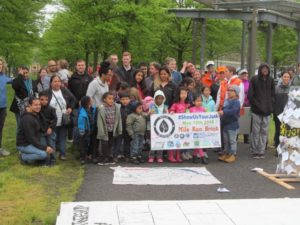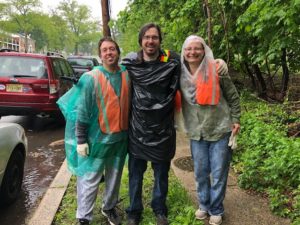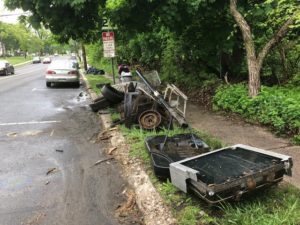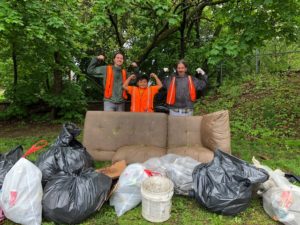Interview by TaeHo Lee, LRWP Fall 2018 Raritan Scholar
On the coldest, windiest day of October 2018, Lower Raritan Watershed Partnership Board Member Amy Braunstein and I met at Hidden Grounds on Easton Ave, a hidden café seven steps below street level, to talk about the LRWP’s new Streamkeeper Program. Amy is the Founder of Friends of Mile Run Brook, and is the LRWP’s first “Streamkeeper” – someone who has committed to stewardship of a local waterway in the Lower Raritan Watershed. Amy has served as Streamkeeper of New Brunswick’s Mile Run Brook for almost a year. Amy has a varied background. She did her undergrad at Rutgers, graduating in 2008 and she recently passed the bar after completing a law degree. She is now practicing law in Newark. While a student, she was an organizer involved in various political campaigns on campus including Tent State and Democrats for Change. She also worked with Food and Water Watch in New Brunswick. She has been an environmentalist since she was a Girl Scout when she had the chance to participate in community clean-ups, but Food and Water Watch reawakened her environmentalism as an adult.
TaeHo: Where are you from in Lower Raritan Watershed, and how did you get involved as Streamkeeper for Mile Run Brook?
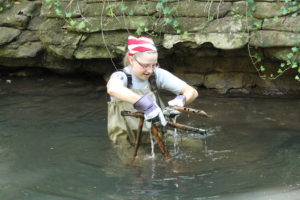
Amy Braunstein, cleaning up Mile Run Brook (photo: John Keller)
Amy: During my senior year of college, I came upon Mile Run Brook while exploring with friends, and fell in love with the stream. I live right next to it now, on Woodbridge Street. We are right on the municipal border between New Brunswick and Franklin, but also the county line between Middlesex and Somerset. Mile Run and the Raritan are natural boundaries.
Living next to Mile Run, I got a pretty good view of a lot of the garbage that was either being dumped in there or washing in there. So I started reaching out among friends and online, just trying to organize some small cleanups on my own. After doing enough cleanups, I wanted to learn more about the actual water quality. And through that I met Heather Fenyk who was active on the New Jersey’s Waters and Save the Raritan River facebook group pages. I asked if anybody had water quality testing kits, and Heather found my Friends of Mile Run Brook facebook page and reached out to me and was like “would you want to help out on these [water quality monitoring] projects?” and then she asked me to help out with formation of the Lower Raritan Watershed Partnership. It’s fine to do things on my own, but working with the Partnership brings so many more resources to the stream, and opportunities to learn more and get more involved in larger watershed issues.
T: Could you tell me what a Streamkeeper is?
A: A Streamkeeper is somebody that has committed to monitoring the vitals of a particular stream, and to providing stewardship for the ongoing health of that stream. This includes the water quality monitoring that we do, things like measuring temperature, speed, depth, and turbidity, and taking a more holistic approach to the activities going on nearby that might impact the stream and possible areas of improvement. It also includes organizing clean-ups and helping people who want to get involved. That is finding folks that would want to help with this effort. A Streamkeeper takes a stewardship role, above and beyond taking data by looking at who is using the stream in terms of not only human recreation but also fish and wildlife and figuring out things that need improvement.
T: Tell me about Mile Run Brook.
A: There is a fascinating history with the stream. Have you seen the documents about the old mine?
T: No!
A: There was an old copper mine that started near where my house is. Somewhere in those backyards was an access tunnel. And it went all the way down past where the new Hillel building is on the Rutgers College Ave campus. The tunnel ran underground. This was back in the Colonial Era. I think it closed up maybe by the end of the 1700s, definitely by the mid-1800s. But that mine shaft is still there. Workers still find it every now and again during construction projects. I don’t know if you’ve ever seen the movie, the Goonies, but it’s an ongoing joke that they found a treasure map and a series of mine shafts and tunnels under this suburban town. And it’s a fantastical adventure with pirate ships and such. We joke about the copper mine in New Brunswick and say “Oh! We got a Goonies’ situation down there!”
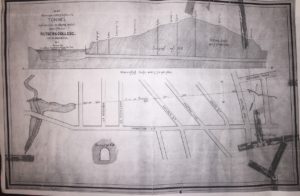
Copy of the map that depicts the copper mine and its mine shaft in New Brunswick
T: (laughter) So, the mine is all filled up now? Or…
A: No, it’s abandoned. Although when they were constructing the Hillel building on College Ave, they found old pickaxes and parts of the dissolved mine. Unfortunately, the reason why this mine opens up over by Mile Run Brook is that, before modern science and human understanding of our effects of pollution on the water systems, people thought water will flush out any garbage left behind and make the area clean, just all of the mine waste and stuff. At one clean up, we found, we’re pretty sure, it was a piece of old coal slab run off from the mine, from the smelting process. And the whole area behind my house is actually a landfill that was capped in the 1930s, I think. And on the Woodbridge St., all of the houses along it were built in the 1950s. Folks would use the stream as a garbage dump. There are pits down there where they found old glass, where they just had been throwing old bottles. Some of these bottles are, in fact, very old. As old as New Brunswick, even. Some of these are hand blown glass. Also – have you seen the name Paulus around? It’s a dairy company in the 1800s in central New Jersey. We found milk bottles from the dairy. This was back when a fleet of milkmen was delivering milk to people.
T: And you found it during a cleanup?
A: We found it one day when I was just kind of walking around with my boyfriend. Sometimes we walk down there to explore. We’d seen some local folks who would walk down with a bucket and then come back out with a bucket full of old looking bottles. And we’re like, “what’s going on down there?” It’s a fascinating history. You know, there’s been people in and around the stream for a long time.
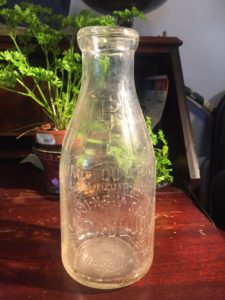
Old hand-blown glass milk bottle from Paulus Dairy that Amy found from the stream.
T: What are current challenges of your Streamkeeper work?
A: The constant challenge is the garbage that is washed in with the stormwater from residential areas. Storm drains lead to our local waterways and a lot of refuse that gets into our streams that way. Also, unfortunately, there is a lot of dumping. I think that doing anti-littering and anti-dumping outreach in a way that is effective and that actually gets people thinking about the effects of their actions is a challenge.
Another challenge more specific to my spot, my geographic proximity along Mile Run Brook, are homeless folks who live there from time to time. Doing outreach with them has been difficult, because there is a lot of fear. When I approach them, they will hear me coming and leave. There’s fear of authorities. There’s fear of having all their stuff stolen. The LRWP has done some great outreach work to these communities in advance of clean-ups. For example, we let them know what’s going on, invite them to join us, and treat them like human beings. The LRWP worked with a social worker to develop outreach material to give them that talks about shelter and food and employment and other social service resources. But, working with those communities, it’s going to be a challenge.
We do want to make that bridge, because they can also be great allies, and there are folks that live near the stream, and it shelters them, and they can be another set of eyes. There’s a lot that we share in common. And I think sometimes people just call the police on them and they get pushed out of the spot and it’s unfortunately a long-term problem in our society that needs to deal with. It’s like the lack of housing and shelter for everybody that needs it. These are kind of like big society problems, but also they relate back to the work with Mile Run Brook. Because the way the things are now… a lot of the homeless people don’t want to be seen and so they will just hide all the evidence of them being there like garbage and food wrappers and all that stuff. And the way they hide them is to just throw it down the ravine.
T: What are some responsibilities that property owners who live adjacent to streams have to maintain the adjacent water bodies?
A: There are two levels: there is legally what is required of them; and then I would say there is kind of like morally and ethically what it is required.
Legally, people cannot discharge any fluids or liquids into the streams. Sometimes folks will be doing home model repair and will not take the proper precautions when emptying radiators or changing the oil. And that stuff can get straight into the stream and have an impact. Also, we have a responsibility to not put any other materials into our local streams. One common mistake that property owners make is just pushing all the leaves, branches, sticks, and debris off of their property and down the ravine into the stream. I mean I think that their thinking is that It’s all natural, it’s not going to make an impact. But this is illegal. And the cumulative impact of everybody pushing all that debris down in there, which would otherwise be scattered evenly on the ground ultimately becoming fertilizers in the waterway, would clog the streams and create stagnant pools.
Another issue confronting New Brunswick residents and homeowners is there is a lot of garbage just in general, and sometimes… you live in New Brunswick, right? So you see that garbage gets blown by the wind. So you can clean up your yard but then stuff can blow in and, I mean, really, it’s on each of us to go through and pull that garbage out of our yard. It is not fair. I didn’t throw it there. It blew in. But that stuff ultimately does make its way into either the trees getting caught or into the streams. So homeowners have responsibilities to remove the garbage or litter, before it is blown into these areas.
Morally and ethically, there is only so much that the law can require people without being coercive or going too far and saying how you live your life. But, I feel like people should look at the impact that their actions make such as how they mow their lawn or what kind of plants they choose to grow. So, where I am at the ravine is very, very steep, and there is an erosion issue. And there is natural plantings and natural ways to just getting those root systems in place to hold the bank in. Or also leaving old or fallen trees undisturbed, they really serve their purpose in streambank reinforcement. Thinking about the impact of each of our actions when it comes to aesthetic improvements to houses, sometimes we will take them in and there will be a bunch of trees and they’ll want a yard. We don’t get those trees back, not in our lifetime. Maybe in our kids’ lifetime if we’re lucky. So, taking positive actions to improve the areas is something that I think falls more into the area of morals and ethics.
One thing the LRWP advocates for that is amazing are pollinator gardens. These are projects the LRWP does in partnership with the New Brunswick Environmental Commission. They will plant milkweed and things that we know that these species are being impacted need in order to survive. Homeowners can easily plant pollinator gardens or native plant species, and they can make choices to not use fertilizers and pesticides. I think doing those kinds of things is really a moral responsibility at this point… Unless each of us tries to make an effort, there is coming a time where there is not going to be enough space for all the creatures of Earth’s biodiversity.
T: What would you like to accomplish in the next five years as a Streamkeeper?
A: let’s see… in 5 years as a stream keeper of Mile Run specifically, I would love for Mile Run to be a stream where people can wade in and fish in and play in as a recreational opportunity. Right now there are issues with stormwater runoff. There used to be a lot of industries along Mile Run – there was a perfume factory and other industrial dischargers dumping directly into the stream. Now the issue is stormwater runoff bringing in trash and other wastes through the stormwater system. Identifying what and where these pollutants are going in and stopping them at the source is goal #1. Maybe we can get Mile Run to be a place where people can really play. I would like to see frogs and lizards and other indicator species return to Mile Run. I would love to see a pathway along the Mile Run so that the members of the public can have a green space to go and recreate in. The more people use it or know it’s there the more they appreciate it. But if it’s just a hidden spot, it’s easier to get trashed and it doesn’t have value. So I would love to see some recreation spaces opened up over there.
T: As a Streamkeeper, do you have any messages to others who may be interested in becoming Streamkeepers?
A: Just explore your streams! Take a look around. All the work I have done to clean-up the stream has benefited me tenfold in terms of my enjoyment of a beautified space. And there is still a lot of hidden beauty in our streams; animals you wouldn’t expect to see. Honestly getting outside and being in nature it’s like… your kids are gonna love it. With a little bit of elbow grease, if we all do a little bit, it’s amazing how beautiful it can be. So, my message would be “go out there, take a look, and get to know the place!”
Following the interview, Amy took me to Mile Run Brook and gave me a brief tour of a section of the stream, from which her house overlooks. We had to be careful around what looked like a homeless spot and spotted a white-tailed deer darting away.
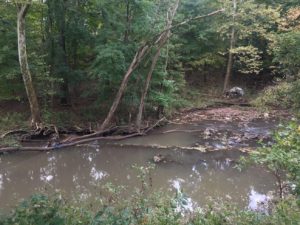
View of Mile Run Brook from Amy’s backyard. On the right of the bank is a homeless community.
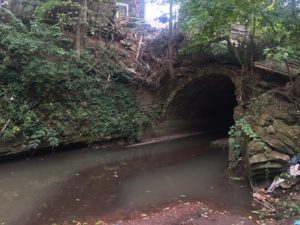
Segment of an old tunnel that Mile Run runs through.
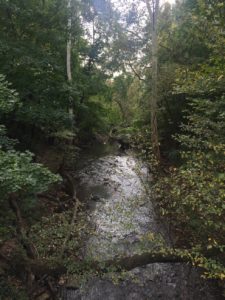
Even after many clean-ups, trash gets blown in, washed in, and dumped into Mile Run Brook
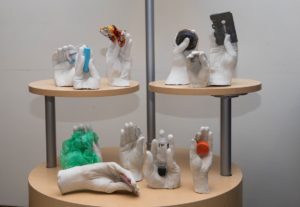 Join the LRWP and coLAB Arts for a “hands-on” watershed sculpture project at the September 23 Mercado in New Brunswick’s Joyce Kilmer Park.
Join the LRWP and coLAB Arts for a “hands-on” watershed sculpture project at the September 23 Mercado in New Brunswick’s Joyce Kilmer Park.
At our September 17 meeting we will welcome Rutgers Cooperative Extension Agent Tobiah Horton to discuss a plan for rooftop and impervious surface drainages recreating an historic New Brunswick stream. The “Recreated Lyell’s Brook Green Infrastructure Corridor and Walkway” concept plan is an outgrowth of the Rail-Arts-River initiative developed by the LRWP, coLAB Arts and Rutgers Cooperative Extension.
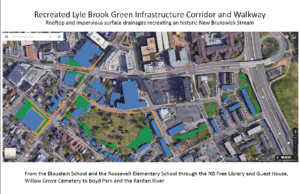
Also on the agenda is catch up on partner activities, status updates for on-going projects, and setting planning priorities for 2019.
The meeting will be held from 10-noon in the Middlesex County Planning Offices at 75 Bayard Street, New Brunswick, NJ – 5th floor mid-size conference room.
Parking is validated for those parking on floors 5 and higher in the RWJ Wellness Parking Deck located at 95 Paterson Street, New Brunswick, NJ 08901. Be sure to bring your ticket to the meeting for validation.
Thank you volunteers!!
It was a gloomy, rainy Saturday, but on May 12, more than 150 people joined the Lower Raritan Watershed Partnership, Greater Brunswick Charter School, Esperanza Neighborhood Partnership, Friends of Mile Run Brook and Elmwood Cemetery for a multi-site community clean-up and celebration of New Brunswick’s Mile Run Brook.
Friends of Mile Run Brook
The clean-up was enlivened by our roving “Trash Troubadour” – Dave Seamon – who engaged our volunteers with song and stories as they cleaned-up the stream. Our Trash Troubadour traveled with a large sculptural bread-and-puppets style bottle (made from trash found during prior clean-ups) that clean-up volunteers covered with messages of environmental hope.

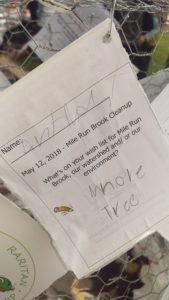
The clean-up was followed by a free community celebration and picnic in New Brunswick’s Boyd Park – with delicious contributions of dishes donated by Panico’s Brick Oven Pizza, La Poncena, Harvest Moon, Pizza Mia and Popeye’s Louisiana Kitchen.
At the end of the clean-up we joined together for a picnic and celebration, the Trash Troubadour created and performed a new song from the messages received.
Filmmaker Jessica Dotson is working on a music video story of the day – a gift for our Mile Run Brook and New Brunswick Community. But for now, click on the photo of our Trash Troubadour to enjoy a youtube video of his riverside performance:
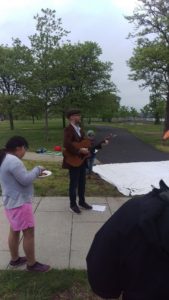
With tremendous thanks to New Brunswick Department of Public Works, North Brunswick Department of Public Works and Rob Hughes, our Americorps Watershed Ambassador for helping with planning, coordination, supplies provision and arranging for disposal of the trash and recycling. Thanks also to the Highland Park Ecology and Environmental Group and Central Jersey Stream Team for bringing your muscle to the clean-up for the day!
Trash Collected at the Hamilton Street Site
Esperanza Neighborhood Project Volunteers!!
The Elmwood Cemetery volunteers (coordinated by the New Brunswick Environmental Commission), removed 14 bags of trash and 6 bags of recycling.
The Greater Brunswick Charter School removed approximately 1,275 pounds of trash and 720 pounds of recycling.
The Esperanza Group removed an estimated 875 pounds of trash and 390 pounds of recycling.
The Friends of the Mile Run removed about 400 pounds of trash and 210 pounds of recycling.
In addition, 20 bulk items and 6 tires were removed as well.
Collectively volunteers removed approximately 2 tons of litter and bulk items from Mile Run Brook!
THANK YOU!!
Article by Allie Oross, photos by Johnny Malpica
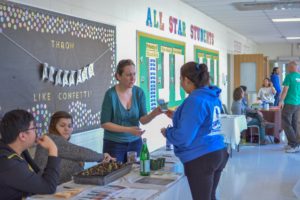
Rutgers Raritan Scholars Interns Justin So and Allie Oross join New Brunswick Environmental Commission Chair Erin Connolly to hand out milkweed seeds at the New Brunswick Food Forum
On a bright morning at 10 AM in the hallways of A. Chester Redshaw Elementary School, tables from multiple community groups lined the halls in anticipation of the 7th Annual New Brunswick Food Forum organized by the New Brunswick Community Food Alliance (NBCFA). Most of the interest groups were related to food and health within the local community and, as the first visitors started to file in, it was evident that these were topics of both concern and interest. Soon the hallways were bustling with adults and children alike from the surrounding neighborhoods.
The Lower Raritan Watershed Partnership (LRWP) table was promoting the importance of pollinator plants (plants that attract pollinator species) as we handed out milkweed seeds and vegetable seedlings. Children could choose to plant their own milkweed seed at one of our tables and many of them enjoyed the opportunity to get their hands dirty.
Pollinators are animals that assist in the fertilization of plants by transferring pollen from the male anatomy of the flower to the female parts. Pollinators can include bees, butterflies, bats, and birds and are essential for plant biodiversity. The number of pollinators in an area has a direct and positive correlation with the general health of an ecosystem. When these biotic vectors rifle around within the flower looking for nectar, pollen gets stuck to their legs or bodies and when they go to the next flower they take that pollen with them. This allows for diverse genotypes within plant populations that would not be seen without the assistance from pollinators.
The LRWP’s goal in handing out milkweed was not only to encourage an increase in pollinator populations in our urban community, but to also increase public awareness and involvement. We asked that people tend to their milkweed plant and watch it grow for two months, then join us and the New Brunswick Environmental Commission for a “pollinator planting day” on Sunday June 17. At that time the plan is to plant the milkweed seedlings and other pollinator plants in New Brunswick’s Buccleuch Park Pollinator Garden. Though most of the people who visited our table were initially unsure what a pollinator was, many took an interest in the health of our environment and were enthusiastic about the prospect of taking an active role in its prospective remediation.
The ability of our environment to efficiently and cohesively function is of drastic importance to every single person that lives within it. Conveniently enough, that same environmental ability depends mostly on the decisions made and actions taken by our very own species.
As Earth day rolls around, it is vital that we reflect on anthropogenic interference in nature and take responsibility for the consequences of over-development and urbanization. If most of the damage to the planet is caused by humans, then it is a logical conclusion that humans also possess the solution. Events like the Food Forum that engage community education and interaction are integral for the remediation of our planet and decreasing the prevalence of apathy and ignorance within our population.
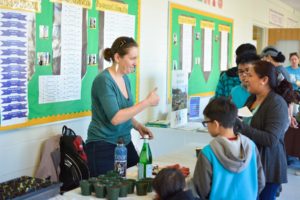
We applaud the following Lower Raritan Watershed towns for securing Sustainable Jersey status in 2017!
East Brunswick – bronze
Edison – bronze
Monroe – bronze
New Brunswick – bronze
Plainsboro – bronze
South Plainfield – bronze
Woodbridge – silver
Hillsborough – silver
Somerville Borough – bronze
Warren Township – silver
Berkeley Heights Township – bronze
Summit City – silver
Extra kudos to New Brunswick, Perth Amboy and Woodbridge for securing 20 points in the “Climate Adaptation: Flooding Risk” action. This action is designed to help communities: 1) identify their vulnerability to flooding impacts (both coastal and inland) and 2) identify ways to improve their overall resiliency. This action focuses on the various causes of flooding that could impact a community, either now or in the future, including increased precipitation, increased frequency of heavy precipitation events, sea level rise and storm surge.
Climate change, population growth, urbanization and industrialization are all putting pressure on our communities and their access to safe and secure water supplies. Sustainable Jersey now awards points for Green Infrastructure Planning and Implementation Actions that can directly improve the water quality of our rivers and streams. Read more about these water-friendly actions on the Sustainable Jersey website.
~VOLUNTEERS NEEDED~ Please join the LRWP, our Americorps Watershed Ambassador and community partners including Friends of Mile Run Brook, Greater Brunswick Charter School, Esperanza Neighborhood Project, the New Brunswick Environmental Commission, Elmwood Cemetery and the New Brunswick Department of Public Works for a multi-site clean-up of Mile Run Brook, culminating in a community celebration in Boyd Park!
WHAT: a clean-up of Mile Run Brook, followed by a community picnic and celebration
WHEN: Saturday May 12
9:00 AM to noon – clean-up of multiple sites.
12-1:30 pm community gathering / picnic in Boyd Park.
WHERE: Multiple sites in New Brunswick
Site 1: Friends of Mile Run Brook / Corner of Hamilton Street and Woodbridge Street
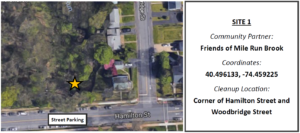
Site 2: Esperanza Neighborhood Project / Corner of French Street and Sandford Street
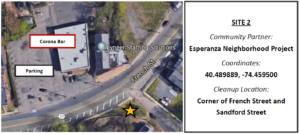
Site 3: Greater Brunswick Charter School (closed group)
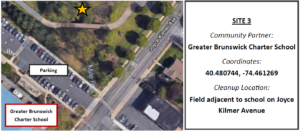
Site 4: Elmwood Cemetery / Entrance at Commercial Avenue
Please wear closed toe shoes and clothes you are willing to get wet and dirty. Gloves and bags will be provided!
WAIVERS
5.12.2018 MRB clean-up waiver, English
Permission and rights granted to LRWP to record and use image and voice, English
For more information
Heather: hfenyk AT lowerraritanwatershed DOT org
or Americorps Watershed Ambassador Rob Hughes: wsamb AT raritanbasin DOT org
In November the New Brunswick Community Arts Council invited the Lower Raritan Watershed Partnership to participate in the inaugural “Windows of Understanding: We see through Hate” project. Windows of Understanding seeks to:
• Counteract the negativity and hate perpetuated in the headlines – by installing community art interventions that illustrate the compassion and love being exercised around us.
• Promote awareness about the vast array of social justice issues being addressed in New
Brunswick, connecting organizations with the wider community and each-other.
• Transform our “Main Street” spaces into literal windows of understanding.
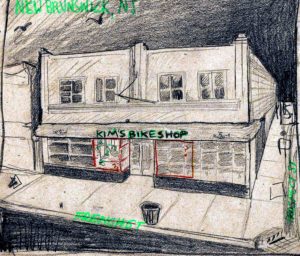
The LRWP was paired with Kim’s Bike Shop (111 French St, New Brunswick, NJ 08901). Working with Kim’s and our coLAB Arts National Endowment for the Arts resident artist Jamie Bruno, the LRWP has developed “Listen to your neighbor, listen to the land” – which will be installed at Kim’s from January 15-February 28. “Listen to your neighbor, listen to the land” reflects the way the LRWP sees through hate as well as the way we hope to connect to our communities. The installation incorporates shoes filled with soil and plants. The shoes represent people, travel, and change. The soil represents our origins in the land.
From Jamie Bruno’s artist statement:
Across religion, race and culture we all spring from the earth and its water and soil. The plants give hope for survival and sustenance: hope to grow new roots and make new connections. The title asks the viewer to listen to their neighbors over the din of every day life. Our neighbors are people who live near us. People who live on the land we live on, yet whose stories we often do not know. In urban environments it can be difficult to know land too, yet she is everywhere: Under the pavement, in the water we drink, in the air we breathe.
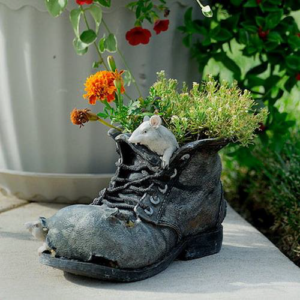 • The shoes represent the human element, the “neighbor” through travel, labor and economic change in addition to empathetic connection across class, race and culture; an admonition to “walk in another’s shoes.”
• The shoes represent the human element, the “neighbor” through travel, labor and economic change in addition to empathetic connection across class, race and culture; an admonition to “walk in another’s shoes.”
• The soil represents land: absorption, filtration, and contamination. Soil health effects human health though the quality of our fruits and vegetables as their roots gather nutrients and the quality of the water in our watersheds as water either filters slowly through healthy soil becoming clean or flows quickly above compacted soil carrying waste.
• The plants represent the hope to grow new roots in new places and to make new connections. Plants store and slow water as it moves through the landscape, further cleaning it, thereby increasing the landscapes inherent value to local wildlife and to neighbors, whether they pass through or decide to stick around and plant their own seeds.
The LRWP and Kim’s invite you to join us from 2-4 PM on Monday January 15, 2018 for the “unveiling” of “Listen to your neighbor, listen to the land” and for refreshments. We will be outside in front of the store planting milkweed for participants to take home, and handing out seed packets for summer gardens.
For more information contact Jamie Bruno: jamie@colab-arts.org
What is the most common type of litter in Boyd Park? Is there more paper or plastic in the grass? How many cigarette butts can you find? How many bottle caps? What is the most unusual item hiding in the bushes?
Join the LRWP and coLAB Arts on Sunday September 10, 10-noon for a River Health Workshop and “Scavenger Hunt” Clean-up of New Brunswick’s Boyd Park!
This event is coordinated in conjunction with the DIY MARKET at Rock New Brunswick. DIY Market is an open air marketplace that celebrates the creativity and spirit of the New Brunswick music scene. It is being held in Boyd Park, alongside a day-long homegrown New Brunswick music festival.
Message and photos by Jamie Bruno.
Editor’s Note: The LRWP and coLAB arts are pleased to welcome Jamie Bruno to our work in New Brunswick. Jamie will join us for the next 9 months as our National Endowment for the Arts Resident Artist.
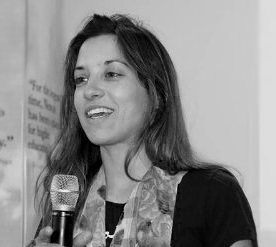
Hello Dear Reader. Happy to be writing to you today.
As the new Resident Artist with the Lower Raritan Watershed Partnership my work is to bring people to the river and bring the river to people. Increasing that knowledge and access increases people’s value of a healthy river and watershed. Much of my work will be dedicated to CoLAB Arts and LRWP’s existing programming such as Rail-Arts-River and Trash Troubadour, within which the already incredible experience of cleaning up a stream also becomes an experience in arts and culture.
I live in Newark, NJ. My most recent work has been focused around urban agriculture, food security, food waste management, and organizing for urban agriculture alliance development. I manage a small farmers market for a local nonprofit once a week at a hospital in Newark. My most recent artwork, “And all our dead can live again,” is a functioning geodesic dome that, in many ways, is a reaction to doing urban agriculture and local food development work in a post-industrial inner city.
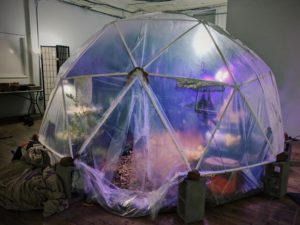
All Our Dead Can Live Again
As a graduate of Rutgers Mason Gross School of the Arts, I am already familiar with New Brunswick though I am still orienting to this new position and a changed city. My eyes see the river differently from the scientists, geologists and academics who study it. Slowly I will see more. For now I notice the strange interactions between humans and the human built riverfront. On my first trip re-visiting Boyd Park I see moments of departure in the landscape by an uncooperative nature, consistently unconcerned with our good intentions. And neglect by us, to simply sit and listen to her. I can’t wait to tell you more about that visit.
You don’t know me and I will only be with you, officially, for a short nine months. But within that nine months I hope that we can make sweet, passionate earth caring goodness together. Earth Care. People care. Future care. In the incredibly succinct lyrics of M.I.A.’s song “Meds and Feds”: We just “give a damn,” and, another inspiration, Y.A.L.A. (You Always Live Again as opposed to the formerly popular phrase, Y.O.L.O., You Only Live Once)… Earth karma.
Thank you for reading. If you’d like to see more of my work please visit tothedirt.net









